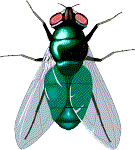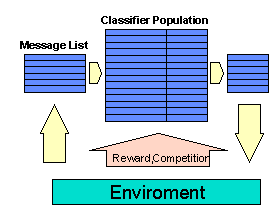 last updated: March 4, 2007
last updated: March 4, 2007
Problem Specification: Develop a adaptive learning
system that learns rule-sets / programs that have been evolved using evolutionary programming,
that process binary inputs from 8
binary input channels and take 4 different actions based on the inputs: 00, 01, 10, 11. Moreover, the classifier
might decide not to take any action at all, called "no action", or 'na' for short.
The classifier receives a reward / punishment
based on its output between 1 and 99 units. Training sequences are specified as a list of
input-payoff pairs; for example:
00001111 00=+04 01=+05 10=-98 11=-02
means that for the input 00001111 the outputs 00 and 01 are rewarded by
4 and 5 units; the outputs 10, 11 result in a punishment of
98 units, and 2 units respectively. If the classifier does not take any action, it receives a
reward of 0 for this action.
Project Philosopy: Each student only choses one approach of the two approaches outlined below.
Students that use the same approach should share the same architecture and might share general
software. However, each student implements his/her individual adaptive learning system!
Rule-based Approach: Design and implement a
classifier system that evolves a single rule-set (
Michigan approach) that consist of rules that are specified using
the following syntax:
"string of
length 8 consisting of 0,1 or *": "output (00,01,10, or 11)"
For example,
1*******:11
represents a rule that selects the
action 11 in the case that the input symbol starts with '1'.
 Design a learning strategy, a conflict
resolution strategy, a default action
selection strategy,
and a learning
schedule of a classifier system of your own choice. A conflict resolution
strategy decides which decision to make, if more than one action is found
in the set of matching classifiers. A learning schedule determines when learning takes
place. A default action selection strategy determines which action will be taken in the
case that no classifier matches the input.
Design a learning strategy, a conflict
resolution strategy, a default action
selection strategy,
and a learning
schedule of a classifier system of your own choice. A conflict resolution
strategy decides which decision to make, if more than one action is found
in the set of matching classifiers. A learning schedule determines when learning takes
place. A default action selection strategy determines which action will be taken in the
case that no classifier matches the input.
Genetic Programing Approach: Develop a genetic programming system that evolves a population
of programs that have 8 input parameters (which are the values of the 8 input channel), and whose fitness is defined
as the reward obtained for the last m training examples (where m is a parameter). First the architecture
of the genetic progamming system has to be determined. The architecture determines the structure of program(s)
evolved and how actions are selected by the classifier system. Second, a learning strategy and a learning
schedule has to be chosen. The learning strategy determines how learning is accomplished: e.g. how
programs are evolved, how their fitness is computed, what roles previously learned programs play in the learning process, etc. The learning schedule determines when learning takes
place.
General Considerations: Be aware of the fact that your classfier system is only allowed to learn from past
experience (violating this constraint will be severely penalized); that is, prescanning
or preanalyzing the training file are
not allowed in the project. Moreover, the classifier
systems is not allowed to use knowledge concerning the feedback of actions that were
not selected for the given input. This, however,
does not prevent you from analyzing the feedback for taken actions for past inputs.
Report the results of running
Benchmark1. Traning sequences in benchmarks consist of either 400 or 1200 examples;
that is, each training sequence consists of 400/1200 input-payoff pairs. Test your system
by giving the same training sequence twice (design your program
in such a way that it can process the input file multiple times) to your system for
each benchmark,
and report the result of running your system for the benchmark. Also
maintain a system bankaccount that keeps track of your system's performance
which is initialized to 0 after seeing the 200th example (that is, the first 200
examples are ignored when evaluating learning performance). Report the value of
this bankaccount after seeing the 300th, 600th, 900th, 1200th, 1500th,... example.
Write
a report (approx. three single spaced pages) that
outlines the architecture of your
learning environment, describes the strategies and algorithms that were used).
Additionally, prepare a second document that lists and
summarizes the results of running your program
for the first benchmark (run your system 4 times for the first
benchmark, and report the results of the 4 runs). Your system
will also be run for a second benchmark during your program demo. Be also prepared
to explain the design and evolution of the program during the program demo.
Add a display option to your program that, everytime the program goes into
learning mode, displays the current rule-set, parameters of individual classifiers
belonging to the current rule-set (e.g. strength,...), your
system's bankaccount, and visualizes the rule-set evolution process (at least in
part). You can use any programming language to perform the project.
Be also aware of the fact that time is limited, and the project has to be
finished in about a month. These requirements have
to be modified for the genetic progamming approach!
 Design a learning strategy, a conflict
resolution strategy, a default action
selection strategy,
and a learning
schedule of a classifier system of your own choice. A conflict resolution
strategy decides which decision to make, if more than one action is found
in the set of matching classifiers. A learning schedule determines when learning takes
place. A default action selection strategy determines which action will be taken in the
case that no classifier matches the input.
Design a learning strategy, a conflict
resolution strategy, a default action
selection strategy,
and a learning
schedule of a classifier system of your own choice. A conflict resolution
strategy decides which decision to make, if more than one action is found
in the set of matching classifiers. A learning schedule determines when learning takes
place. A default action selection strategy determines which action will be taken in the
case that no classifier matches the input.
 last updated: March 4, 2007
last updated: March 4, 2007